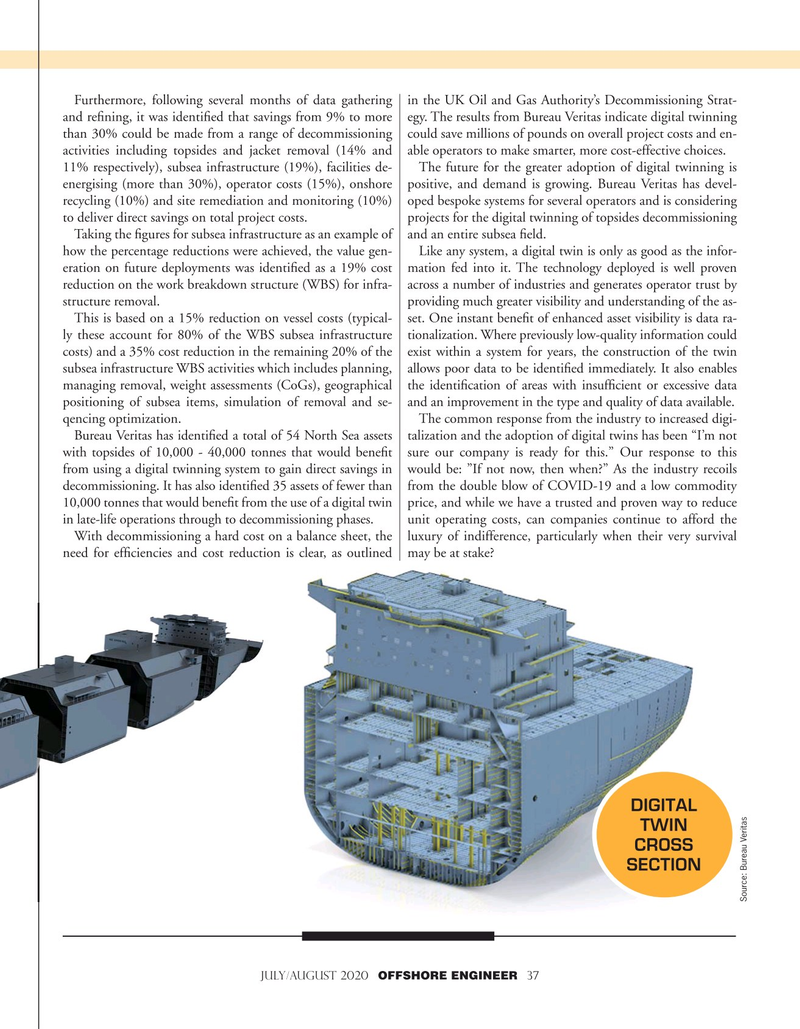
Page 37: of Offshore Engineer Magazine (Jul/Aug 2020)
Read this page in Pdf, Flash or Html5 edition of Jul/Aug 2020 Offshore Engineer Magazine
Furthermore, following several months of data gathering in the UK Oil and Gas Authority’s Decommissioning Strat- and re?ning, it was identi?ed that savings from 9% to more egy. The results from Bureau Veritas indicate digital twinning than 30% could be made from a range of decommissioning could save millions of pounds on overall project costs and en- activities including topsides and jacket removal (14% and able operators to make smarter, more cost-effective choices.
11% respectively), subsea infrastructure (19%), facilities de- The future for the greater adoption of digital twinning is energising (more than 30%), operator costs (15%), onshore positive, and demand is growing. Bureau Veritas has devel- recycling (10%) and site remediation and monitoring (10%) oped bespoke systems for several operators and is considering to deliver direct savings on total project costs. projects for the digital twinning of topsides decommissioning
Taking the ?gures for subsea infrastructure as an example of and an entire subsea ?eld.
how the percentage reductions were achieved, the value gen- Like any system, a digital twin is only as good as the infor- eration on future deployments was identi?ed as a 19% cost mation fed into it. The technology deployed is well proven reduction on the work breakdown structure (WBS) for infra- across a number of industries and generates operator trust by structure removal. providing much greater visibility and understanding of the as-
This is based on a 15% reduction on vessel costs (typical- set. One instant bene?t of enhanced asset visibility is data ra- ly these account for 80% of the WBS subsea infrastructure tionalization. Where previously low-quality information could costs) and a 35% cost reduction in the remaining 20% of the exist within a system for years, the construction of the twin subsea infrastructure WBS activities which includes planning, allows poor data to be identi?ed immediately. It also enables managing removal, weight assessments (CoGs), geographical the identi?cation of areas with insuf?cient or excessive data positioning of subsea items, simulation of removal and se- and an improvement in the type and quality of data available.
qencing optimization. The common response from the industry to increased digi-
Bureau Veritas has identi?ed a total of 54 North Sea assets talization and the adoption of digital twins has been “I’m not with topsides of 10,000 - 40,000 tonnes that would bene?t sure our company is ready for this.” Our response to this from using a digital twinning system to gain direct savings in would be: ”If not now, then when?” As the industry recoils decommissioning. It has also identi?ed 35 assets of fewer than from the double blow of COVID-19 and a low commodity 10,000 tonnes that would bene?t from the use of a digital twin price, and while we have a trusted and proven way to reduce in late-life operations through to decommissioning phases. unit operating costs, can companies continue to afford the
With decommissioning a hard cost on a balance sheet, the luxury of indifference, particularly when their very survival need for ef?ciencies and cost reduction is clear, as outlined may be at stake?
DIGITAL
TWIN
CROSS
SECTION
Source: Bureau Veritas
JULY/AUGUST 2020 OFFSHORE ENGINEER 37

 36
36

 38
38